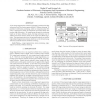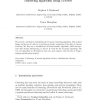123
click to vote
TVLSI
2010
14 years 7 months ago
2010
K-Means is a clustering algorithm that is widely applied in many fields, including pattern classification and multimedia analysis. Due to real-time requirements and computational-c...
146
click to vote
MLDM
2010
Springer
14 years 7 months ago
2010
Springer
In this paper we study the k-means clustering problem. It is well-known that the general version of this problem is NP-hard. Numerous approximation algorithms have been proposed fo...
117
Voted
CLASSIFICATION
2010
14 years 10 months ago
2010
: The issue of determining "the right number of clusters" in K-Means has attracted considerable interest, especially in the recent years. Cluster intermix appears to be a...
265
Voted
ICASSP
2011
IEEE
14 years 10 months ago
2011
IEEE
The scope of the well-known k-means algorithm has been
broadly extended with some recent results: first, the k-
means++ initialization method gives some approximation
guarantees...
94
Voted
ICONIP
2009
14 years 10 months ago
2009
There is an ever increasing number of electronic documents available today and the task of organizing and categorizing this ever growing corpus of electronic documents has become t...
129
click to vote
ICANNGA
2009
Springer
14 years 10 months ago
2009
Springer
Abstract This research deals with the use of self-organising maps for the classification of text documents. The aim was to classify documents to separate classes according to their...
85
Voted
ICPR
2010
IEEE
14 years 10 months ago
2010
IEEE
Although many methods of refining initialization have appeared, the sensitivity of K-Means to initial centers is still an obstacle in applications. In this paper, we investigate a...
123
Voted
ICIP
2010
IEEE
14 years 10 months ago
2010
IEEE
A new image segmentation method is proposed to combine the edge information with the feature-space method, K-Means clustering. A procedure called seam processing, which is computa...
136
Voted
FOCS
2010
IEEE
14 years 10 months ago
2010
IEEE
We consider k-median clustering in finite metric spaces and k-means clustering in Euclidean spaces, in the setting where k is part of the input (not a constant). For the k-means pr...
102
click to vote
PRL
2007
15 years 9 days ago
2007
We present a method for initialising the K-means clustering algorithm. Our method hinges on the use of a kd-tree to perform a density estimation of the data at various locations. ...


